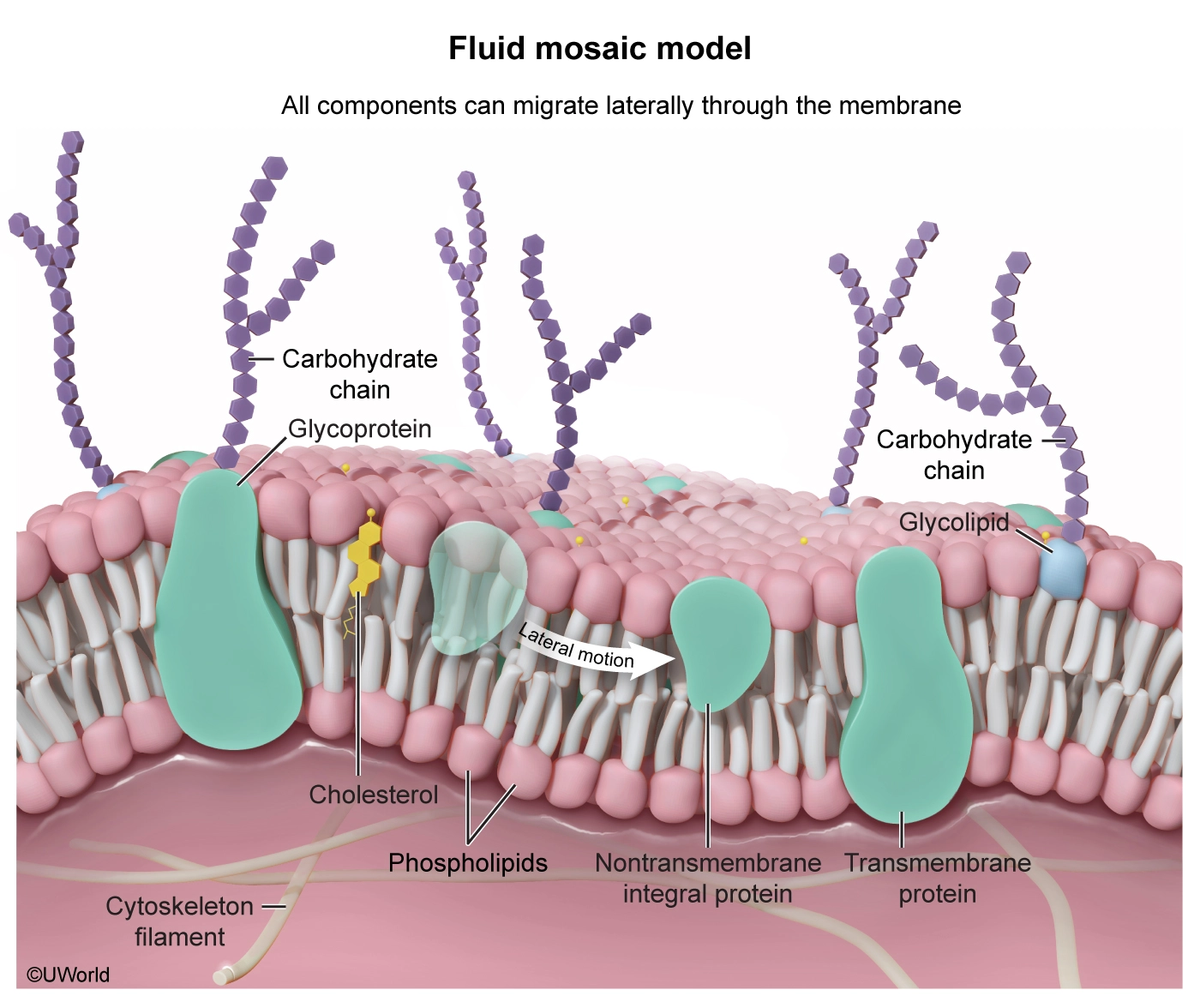MCAT® Biology
Topics, Practice Questions, and Study Strategies
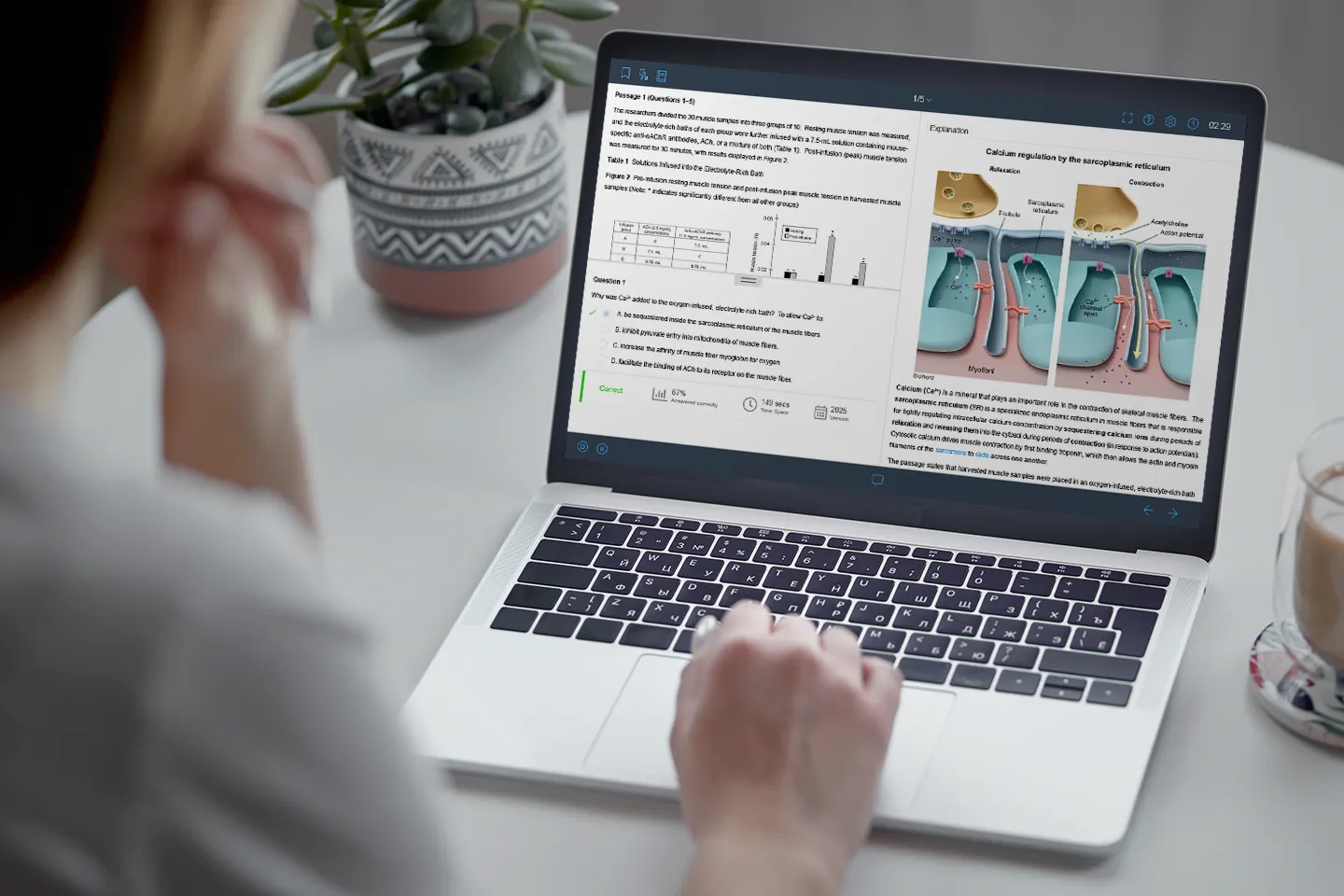
The MCAT Biological Sciences section consists of 52 questions. It covers topics like protein and nucleic acid structures, DNA, and membrane-bound organelles. Here are some of the core disciplines and percentages you can expect to encounter on the MCAT:
- First-Semester Biochemistry (25% of the exam)
- Introductory Biology (65% of the exam)
- General Chemistry (5% of the exam)
- Organic Chemistry (5% of the exam)
Explore Essential MCAT Biology Topics
In the MCAT biology section, you’ll have approximately 95 minutes to answer 59 questions, including ten passages with 4-6 questions each. Since you’ll only have 1.6-1.9 minutes per question, it’s vital to look for comprehensive test prep and study tools to ensure you feel well-prepared on exam day. Let’s dive into core concepts you’ll find in the MCAT biology section.
Foundational Biology Concepts
- Protein Structure
- Non-Enzymatic Protein Function
- Enzyme Structure and Function
- Control of Enzyme Activity
- Nucleic Acid Structure and Function
- DNA Replication
- Repair of DNA
- Genetic Code
- Transcription and Translation
- Eukaryotic Chromosome Organization
- Control of Gene Expression in Prokaryotes and Eukaryotes
- Recombinant DNA and Biotechnology
- Mendelian Concepts and Meiosis
- Analytic Methods and Evolution
- Glycolysis, Gluconeogenesis, and the Pentose Phosphate Pathway
- Citric Acid Cycle and Metabolism of Fatty Acids and Proteins
- Oxidative Phosphorylation
- Plasma Membrane and Membrane-Bound Organelles
- Cytoskeleton
- Tissues Formed from Eukaryotic Cells
- Cell Theory and Classification
- Growth, Physiology, and Genetics of Prokaryotic Cells
- Virus Structure and Life Cycle
- Mitosis and the Reproductive System
- Embryogenesis
- Mechanisms of Development
- Nervous System: Structure and Function
- Nerve Cell
- Endocrine System: Hormones and Their Sources
- Endocrine System: Mechanisms of Hormone Action
- Respiratory, Circulatory, and Lymphatic Systems
- Immune, Digestive, and Excretory Systems
- Reproductive, Muscle, Skeletal, and Skin Systems
How Is Biology Tested on the MCAT?
Studying for the Biology section of the MCAT requires a deep understanding of robust systems, processes, and theories. UWorld is here to make your MCAT journey successful by providing engaging, immersive prep content and learning tools. There are four different topics assessed during the MCAT bio section. Here’s how each one breaks down:
- Skill 1 Questions (Knowledge of Scientific Concepts and Principles) comprise 35% of the Biology/Biochemistry section.
- Skill 2 Questions (Scientific Reasoning & Problem-Solving) make up 45% of the Biology/Biochemistry segment.
- Skill 3 Questions (Reasoning about the Design and Execution of Research) constitute 10% of the Biology/Biochemistry portion.
- Skill 4 Questions (Data-based Statistical Reasoning) are 10% of the Biology/Biochemistry section.
Establishing the Groundwork: Skill 1
This segment tests your knowledge of core biological principles that don’t require deep reasoning skills. You’ll demonstrate your understanding of fundamental concepts by reading passages or interpreting processes. Take a look at the types of concepts and questions you might encounter on the MCAT.
| Core Concept | Example Question Type |
|---|---|
| Cell Biology | Identify the main components of a eukaryotic cell and describe their functions. |
| Biochemistry | Explain the process of enzyme catalysis and how substrate concentration affects reaction rates. |
Navigating Scientific Logic: Skill 2
Apply your biological knowledge to think critically about scientific theories. Evaluate reasoning, assess credibility, identify scientific findings, and use formulas to solve mathematical equations.
| Core Concept | Example Question Type |
|---|---|
| Genetics and Inheritance | Solve a problem involving gene linkage and genetic recombination. |
| Microbiology | Evaluate the efficacy of different antibiotics against bacterial infections. |
Applying Your Understanding of Design and Research Principles: Skill 3
Answer questions about how scientists design and manipulate research experiments. You’ll need to show your understanding of:
- Scientific methodology
- Ethical considerations
- Critical evaluation
| Core Concept | Example Question Type |
|---|---|
| Anatomy and Physiology | Analyze the limitations of a study investigating the effects of a drug on cardiovascular function. |
| Evolution | Identify the variables and controls in an experiment studying speciation. |
Interpreting Data, Statistics, and Diagrams: Skill 4
Finally, you’ll master the biochemistry section of the MCAT by analyzing data presented in various formats, such as tables, graphs, and charts. You’ll use statistical concepts to draw conclusions.
| Core Concept | Example Question Type |
|---|---|
| Ecology | Evaluate a graph representing the population dynamics of a keystone species in an ecosystem. |
| Cell Biology | Interpret a graph illustrating changes in cell membrane potential over time. |
Review Sample Questions from the MCAT Biology Section
Take a look at the AAMC-style questions in our QBank provided below. Submit your answers to experience UWorld's fun and engaging test prep, designed to help you achieve your dream career.
The nicotinic acetylcholine receptor (nAChR) is a protein embedded in the muscle fiber membrane that facilitates cell-to-cell communication across the neuromuscular junction. When acetylcholine (ACh) binds nAChR, electrical depolarization within skeletal muscle fibers is induced and ultimately gives rise to contractile activity. The nAChR is composed of five protein subunits symmetrically organized around a central ion pore. Previous studies demonstrated that these subunits may serve as epitopes (antibody binding sites) in autoimmune disease. By reversibly binding nAChR subunits, anti-nAChr antibodies may temporarily block the attachment site for ACh, resulting in muscle weakness.
In preliminary studies for a research proposal, researchers harvested muscle samples from mice to investigate the effects of anti-nAChR antibodies on muscle tension, the pulling force transmitted by muscles during contraction.
Experiment 1
First, skeletal muscle samples (tibialis anterior) of adult male mice were surgically harvested (n = 30), washed, and stripped of connective tissues. Next, the isolated muscle samples were placed in a 150-mL oxygen-infused, electrolyte-rich bath containing glucose and Ca2+ ions that were able to enter the muscle fibers and enable maximal contractile force. One end of the submerged muscle was anchored in place while the other was attached to an apparatus that measures muscle tension and modifies muscle length. Using electrodes, action potentials were elicited in the harvested muscle tissue to evaluate contractile function (Figure 1).
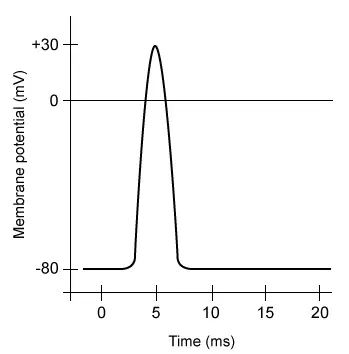
Figure 1 Action potential elicited from a harvested skeletal muscle sample
Experiment 2
The researchers divided the 30 muscle samples into three groups of 10. Resting muscle tension was measured, and the electrolyte-rich baths of each group were further infused with a 7.5-mL solution containing mouse-specific anti-nAChR antibodies, ACh, or a mixture of both (Table 1). Post-infusion (peak) muscle tension was measured for 30 minutes, with results displayed in Figure 2.
Table 1 Solutions Infused into the Electrolyte-Rich Bath
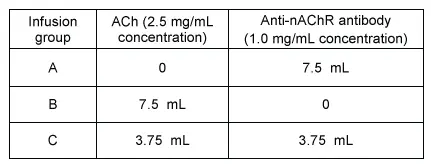
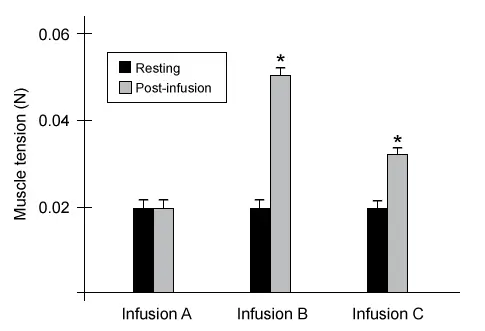
Figure 2 Pre-infusion resting muscle tension and post-infusion peak muscle tension in harvested muscle samples (Note: * indicates significantly different from all other groups)
Why was Ca2+ added to the oxygen-infused, electrolyte-rich bath? To allow Ca2+ to:
| A. be sequestered inside the sarcoplasmic reticulum of the muscle fibers. | ||
| B. inhibit pyruvate entry into mitochondria of muscle fibers. | ||
| C. increase the affinity of muscle fiber myoglobin for oxygen. | ||
| D.facilitate the binding of ACh to its receptor on the muscle fiber. |
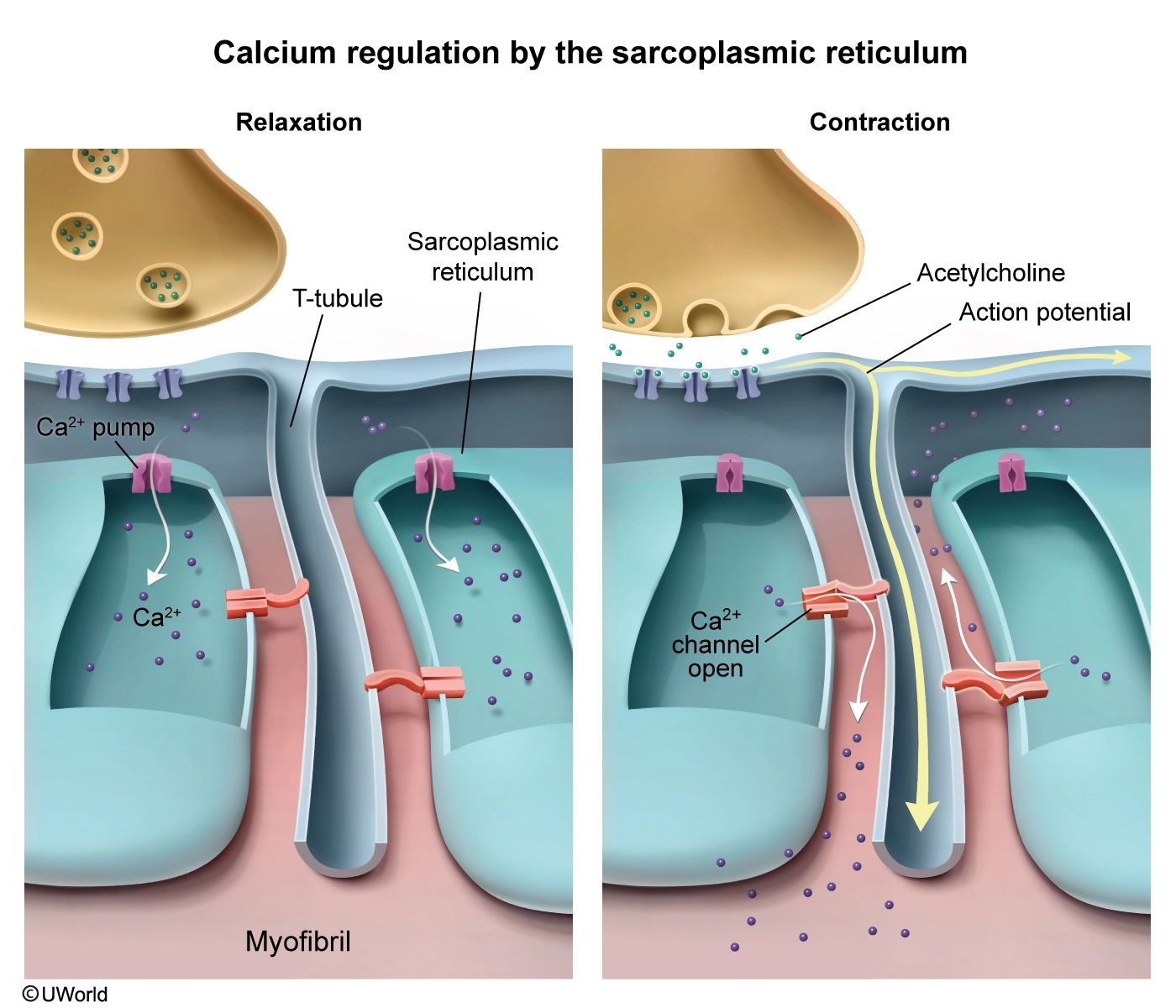
Calcium (Ca2+) is a mineral that plays an important role in the contraction of skeletal muscle fibers. The sarcoplasmic reticulum (SR) is a specialized endoplasmic reticulum in muscle fibers that is responsible for tightly regulating intracellular calcium concentration by sequestering calcium ions during periods of relaxation and releasing them into the cytosol during periods of contraction (in response to action potentials). Cytosolic calcium drives muscle contraction by first binding troponin, which then allows the actin and myosin filaments of the sarcomere to slide across one another.
The passage states that harvested muscle samples were placed in an oxygen-infused, electrolyte-rich bath that contained Ca2+ ions; it also states that these ions could enter the muscle fibers and enable maximal contractile force. Based on this information, the calcium ions in the bath were able to enter and aggregate inside the SR of the muscle fiber samples, enabling their contractile activity.
(Choice B) Muscle fibers can generate ATP through both glucose and fat metabolism. Pyruvate entry into mitochondria is necessary for pyruvate oxidation as well as subsequent use of pyruvate in the citric acid cycle, both of which occur inside mitochondria and are important to meet the energetic demands of muscle, particularly during contractions. Therefore, the researchers would not have added Ca2+ to inhibit pyruvate entry into mitochondria.
(Choice C) Iron, not calcium, facilitates oxygen binding by the proteins myoglobin and hemoglobin. Myoglobin stores oxygen within muscle fibers, and hemoglobin is an oxygen carrier molecule found in red blood cells that allows oxygen to be transported throughout the body.
(Choice D) At the neuromuscular junction, the entry of calcium ions into presynaptic neurons leads to the release of ACh from the presynaptic vesicles and into the synaptic cleft, where ACh then binds its receptor on the muscle fiber membrane. However, because the muscle fibers in the electrolyte bath were completely isolated, no presynaptic neurons were present, and calcium only served to supply the SR of the muscle fibers.
Educational objective:
The sarcoplasmic reticulum (SR) is a muscle
fiber organelle that tightly regulates intracellular calcium (Ca2+)
concentration. The release of calcium from the SR promotes muscle fiber contraction
whereas the transport of calcium into the SR promotes and maintains muscle fiber relaxation.
In humans, skeletal muscles are innervated by the somatic nervous system. An example of skeletal muscle function is mediation of:
| A.contraction of blood vessel walls. | ||
| B. resting heart rate. | ||
| C.propulsion of food contents along the digestive tract. | ||
| D. movement of the jaw during chewing. |
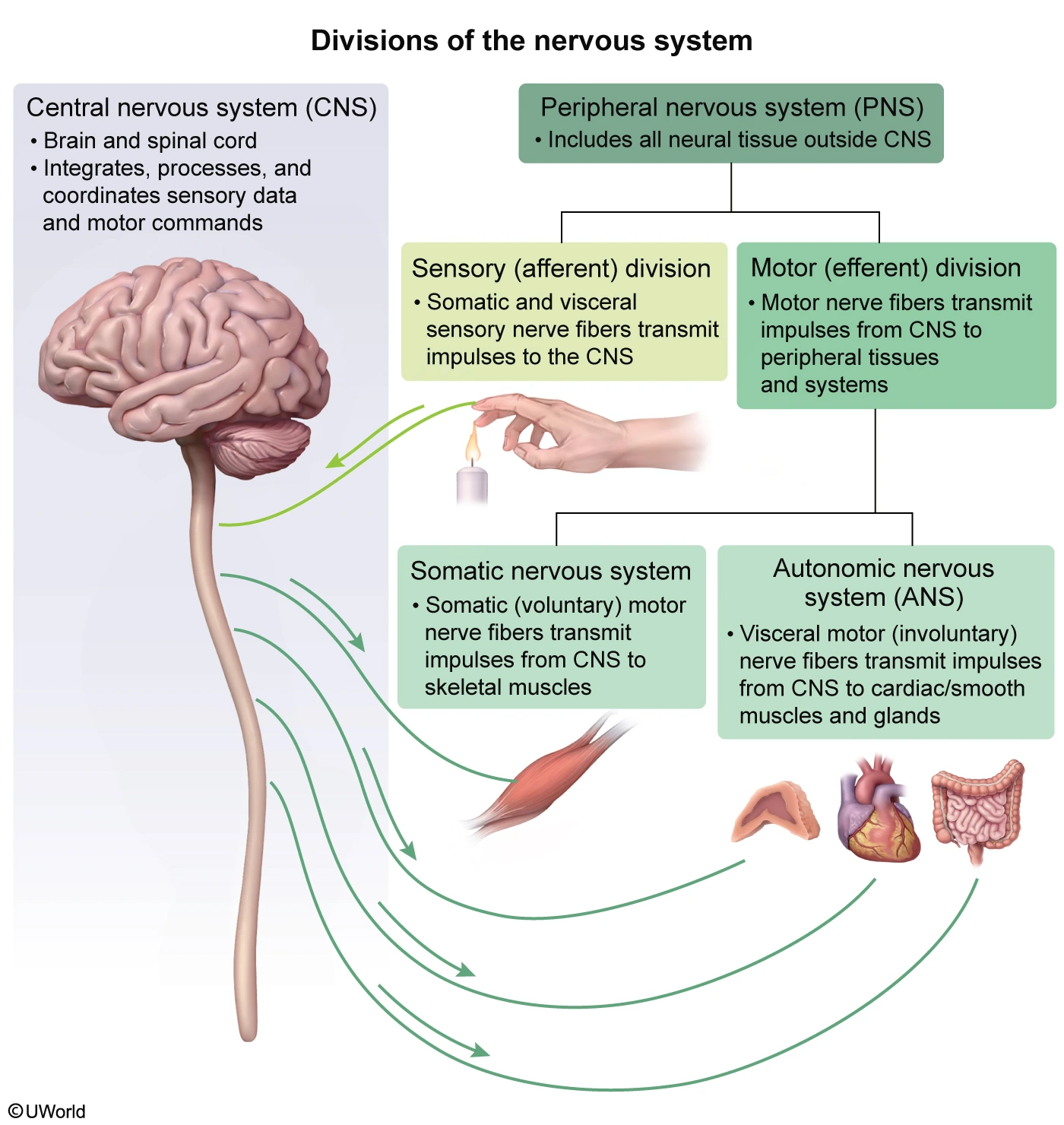
The peripheral nervous system consists of all nerves and neurons located outside the central nervous system (ie, the brain and spinal cord). The peripheral nervous system has two branches: the autonomic nervous system and the somatic nervous system.
The motor nerve fibers of the somatic nervous system transmit impulses from the central nervous system to the skeletal muscles of the body, allowing individuals to consciously control and perform specific movements. As a result, all movements carried out on a voluntary basis are mediated by the somatic nervous system. Examples of voluntary movements include activities such as walking, talking, and movement of the jaw during chewing.
In contrast, the autonomic nervous system mediates subconscious, automatic functions that are not subject to voluntary control. Accordingly, the activity of glands, smooth muscles, and cardiac muscles is regulated by the visceral motor nerve fibers of the autonomic nervous system. For example, the smooth muscles located within the walls of blood vessels can contract (Choice A) or relax to constrict or dilate the vessel, and the smooth muscle sheets in the walls of the gastrointestinal tract alternately contract and relax to propel food contents along the gut (peristalsis) (Choice C).
The contraction of cardiac muscle is another automatic, involuntary process regulated in part by the autonomic nervous system (Choice B). Although the action potentials necessary for cardiac contraction are generated by cardiac tissue independent of nervous system input, the activity of autonomic nerves influences the frequency and intensity of cardiac contraction.
Educational objective:
The somatic and autonomic nervous systems are
the two branches of the peripheral nervous system. Voluntary activities occur through
the contraction of skeletal muscles, which is mediated by the somatic nervous system.
A mutant mouse is found to exhibit nearly normal in vivo musculoskeletal function following the administration of anti-nAChR antibodies. Compared to a wild-type mouse administered the same antibodies, this mutant mouse is most likely to show which of the following changes at the neuromuscular junction?
| A. Decreased ACh degradation within the synapse | ||
| B. Increased expression of acetylcholine-degrading enzymes by skeletal muscle fibers | ||
| C. Increased reuptake of ACh degradation byproducts into the presynaptic neuron | ||
| D.Reduced release of ACh from the presynaptic vesicles |
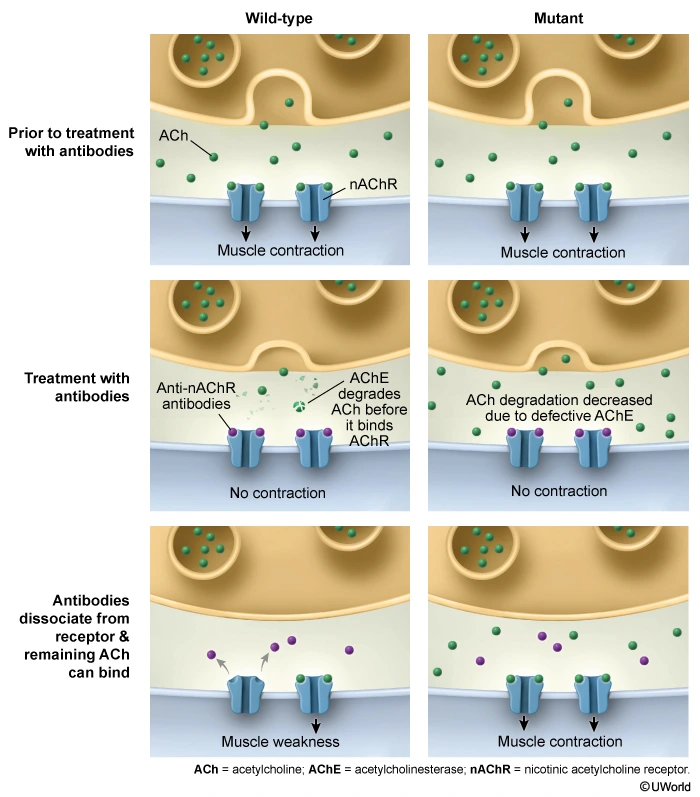
The interface between a somatic motor neuron and a skeletal muscle fiber is a specialized synapse known as the neuromuscular junction (NMJ). The NMJ converts motor neuron action potentials into muscle fiber action potentials.
The arrival of an action potential at the axon terminal of the presynaptic motor neuron triggers release of ACh from presynaptic vesicles into the synaptic cleft via exocytosis. The ACh diffuses across the synaptic cleft to bind nicotinic ACh receptors (nAChRs) embedded within the membrane of the postsynaptic muscle fiber, eventually leading to muscle contraction. Unbound ACh may diffuse away from the synapse or be degraded by the enzyme acetylcholinesterase (AChE), terminating muscle fiber contraction.
Based on the passage, anti-nAChR antibodies bind nAChR reversibly to block the interaction between ACh and nAChR, resulting in muscle weakness. Accordingly, administration of these antibodies in a wild-type mouse would temporarily prevent binding of ACh to its receptor. Consequently, the unbound Ach in the synaptic cleft of these wild-type mice would likely be degraded before being able to bind nAChR, decreasing muscle contraction.
However, if a mutant mouse were to exhibit normal muscle contraction despite being treated with anti-nAChR antibodies, a likely explanation could be that ACh degradation within the mutant's synapse is decreased compared to that of the wild-type. Decreased ACh degradation would increase the number of ACh molecules available to bind nAChRs after these receptors are no longer bound by anti-nAChR antibodies. This would likely allow muscles to eventually exhibit normal contraction despite the presence of anti-nAChR antibodies.
In contrast, the following changes would not likely mediate the improved muscle function observed in the mutant mice receiving anti-nAChR antibodies:
-
Increased expression of ACh-degrading enzymes (ie, acetylcholinesterases) would decrease synaptic ACh, contributing to (not improving) muscle weakness (Choice B).
-
ACh degradation products (eg, choline) can reenter the presynaptic terminal to be recycled for acetylcholine synthesis. However, increased reuptake of ACh degradation products would likely require more rapid ACh degradation to produce these recyclable materials. Consequently, increased ACh degradation would decrease ACh availability for nAChR binding, causing muscle weakness (Choice C).
-
Following motor neuron action potentials, reduced release of ACh from the presynaptic vesicles would decrease the quantity of ACh released into the synapse, also leading to muscle weakness (Choice D).
Educational objective:
Acetylcholine (ACh) degradation within the
neuromuscular junction contributes to termination of muscle contraction. However,
decreased ACh degradation would allow more ACh molecules to remain in the synapse and
prolong stimulation of nAChR and subsequent muscle contraction.
Build Your Complex Problem-Solving Skills With These 5 Helpful MCAT Biology Study Tips
Review for the MCAT is typically dense and time-consuming, but it doesn’t have to be. Using proven study tips and a dynamic learning platform will provide an immersive learning experience that simulates the real MCAT, ensuring you earn a top score.
Anatomy and physiology are technically not prerequisites for medical school, but you’ll need to know this material for the MCAT. Ensure your study materials cover all essential biological foundations to give you the most comprehensive prep experience.
Actually, you can save time using an online notebook to capture and review MCAT content. Instead of spending hours compiling your notes by hand, instantly record MCAT content using a personalized digital note-taking tool that seamlessly organizes your notes. Easily browse concepts, like anatomy and physiology, boosting study performance in less time.
Challenge yourself with sophisticated problem-solving exercises specific to biology. Enhance your analytical skills to tackle complex scenarios related to cellular biology, genetics, and ecological systems. A learning platform with built-in concept checks helps test your knowledge of in-depth biological topics. You should be building critical thinking skills throughout your MCAT prep journey so you feel confident on exam day. Take a look at an example question below.
| Background | Example Question |
|---|---|
| A biologist studies the behavior of a particular species of birds in a forest ecosystem. The researcher notices a sudden decline in the bird population and wants to investigate the possible causes. | Develop a research question, propose a series of experiments to explore potential factors contributing to the decline, and outline the steps you would take to analyze the data. Consider ecological, genetic, and environmental factors in your experimental design. Integrate your ecology, genetics, and experimental design knowledge to address this real-world scenario. |
Different people get different topics wrong for various reasons. Use wrong answers to address patterns and behaviors you’re making. Monitor your progress, identifying your strengths and weaknesses. Tailor your preparation to focus on areas that you need to study the most, enhancing your test-taking confidence.
Familiarize yourself with DNA and cellular structures like double helix shapes, the nucleus’s function, and the transcription and translation processes. Recall, then apply these concepts using flashcards to strengthen any knowledge gaps.
In fact, intuitive test prep will include digital flashcards with spaced-repetition technology that adapts to your study progress. Each flashcard allows learners to enhance long-term retention by strategically spacing out the intervals at which they review information. Here’s how spaced repetition flashcards work:
- Adaptive Learning: The flashcards are part of an adaptive learning system that uses technology to determine when and how frequently a learner should review specific pieces of information.
- Gradual Spacing: Over time, as the learner continues to review the flashcards, the intervals between reviews gradually increase.
- Focus on Weak Areas: Spaced repetition systems prioritize the review of flashcards in areas where the learner has demonstrated weaker recall. This ensures efficient use of study time by concentrating efforts on challenging concepts.
Simulate the exam environment with practice tests that mirror AAMC-style content and adhere to timed conditions. This will help you feel comfortable taking the actual MCAT.
Frequently Answered Questions
Are MCAT biology questions hard?
MCAT biology questions can be difficult but doable with the right study strategy and learning tools. Choose immersive MCAT prep with detailed illustrations and explanations for the best study experience.
What level of biology is on the MCAT?
The level of biology on the MCAT is the same material you’ve seen in your undergraduate classes. Review what you’ve learned so far to be successful on the MCAT.
Is the MCAT mostly biology?
No, biology only appears in the Chemistry/Physics and Biology/Biochemistry sections of the MCAT. In the Chemistry/Physics Section, Biology only comprises 5% of the entire section. Alternatively, Biology makes up 65% of the Biology/Biochemistry section.
Does UWorld provide free MCAT biology sample questions?
UWorld provides AAMC-style MCAT Sample questions to help you prepare for the MCAT. Sign up for your FREE trial to shape your future in healthcare! Start making an impact – today.





